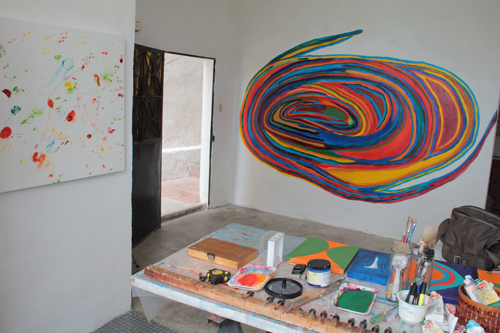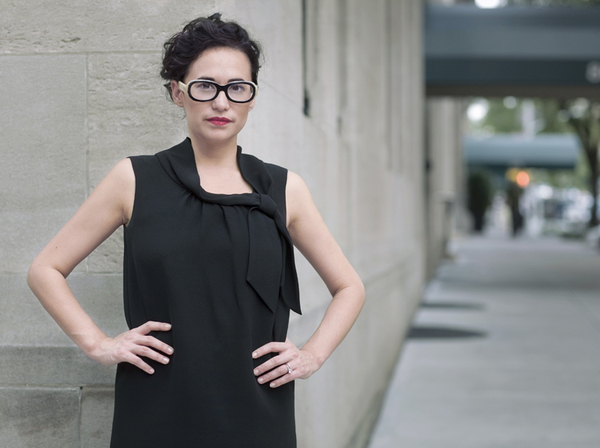
Sofía Hernández Chong Cuy, Curator of Contemporary Art at Colección Patricia Phelps de Cisneros (CPPC).
Sofía Hernández Chong Cuy is the Curator of Contemporary Art at Colección Patricia Phelps de Cisneros. Between 2009-2010, she served as the director of Museo Tamayo in Mexico City. Before then, she worked as curator at Art in General and earlier at Americas Society, both nonprofit arts organizations in New York City. She has curated independently: Autopsia de lo invisible at MALBA in Buenos Aires, Argentina; Archaeology of Longing at Kadist Art Foundation in Paris, France, where she was in residence for part of 2008; and together with Raimundas Malasauskas and Alexis Vaillant, the IX Baltic Triennial Black Market Worlds (a.k.a. BMW). Hernández Chong Cuy writes regularly for exhibition catalogues and art magazines, as well as for her blog, www.sideshows.org.
Having followed Sofía Hernández Chong Cuy’s curatorial practice for a decade now, I am very pleased to present to you our discussion on contemporary Latin American art and Hernández Chong Cuy’s current projects.

Mariana Castillo Deball. Grabmaske Peruanis Cheskustengebeit, from the series Falschgesichter, 2008. Laser print and fold on couche paper. 29 x 27 cm. Colección Patricia Phelps de Cisneros.
Georgia Kotretsos: You just held a seminar series at the Konshall, Spånga on “What Does an Art Institution Do?” The inquiring spirit of that program invites dialogue, so I would like to begin by asking you this very question – since thus far your name has always been closely linked to an art institution. I’d also like you to consider, what do art institutions do for you?
Sofía Hernández Chong Cuy: I think the title of the program is telling; simple but challenging. It titillates with the not-knowing. It doesn’t exactly invite a naïve albeit possibly-interested public that may want to learn about the role of art institutions, though it may, but rather, it is an invitation to reflect on art institutions’ commitments to a public. Since “doing” involves affect and effect simultaneously, it collapses motivation and end at once, at least in the title of the program. There are certainly many kinds of “doings” in the world, and thus many kinds of art institutions. I’ve worked in a variety of cities and institutions, and in each one, these so-called doings—whether you call it art or culture, niceties or politics—and their so-called institutions are very different from each other.
At the CPPC, the mission is focused on promoting the artistic and cultural contributions of Latin America. (That’s almost a third of the world! There is really a lot to experience, to see, to think about and share.) We do several things. First of all, we research. Secondly, we collect. Thirdly, we communicate our findings through exhibitions, publications, programs and other initiatives. And, fourthly, we advocate. In every step of the way, we collaborate. Ultimately, we do all this so that the collections, research, and findings can collaboratively change art histories—or at least introduce new paradigms, sensibilities and narratives. I will be talking about this in detail during the seminar.
I should add that I am very honored to participate in this series of talks, which involve two very dear colleagues who I’ve worked with closely throughout the years—Maria Lind, who has organized the program and is the director at Tensta Konstal, and Kate Fowle, the director of ICI in New York, who is a co-presenter in the seminar. Maria Lind’s “Sputnik” initiative at Kunstverein in Munich—engaging artists and thinkers alike to actively inflect and reflect on institutional practices— has been very influential, and Kate’s insistence on creating educational opportunities for curators is admirable. You may also already know that ICI and CPPC recently partnered to offer a curatorial research travel grant; the award will be announced in a matter of days.
GK: Being the curator of the contemporary collection at the Colección Patricia Phelps de Cisneros (CPPC) presents you with the challenge of re-thinking what else could be done with a solid record of contemporary Latin American art in the art world. What do you have in mind?
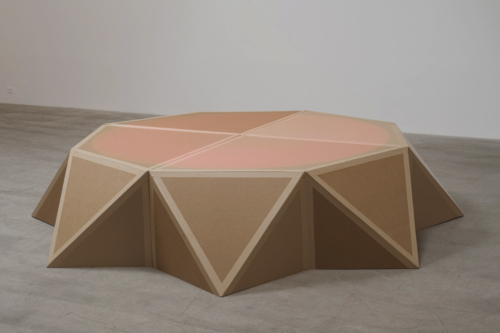
Amalia Pica. Stage (as seen on Afghan Star), 2011. Cardboard, wood, tape, spotlight. 25.4 x 279.4 cm. Colección Patricia Phelps de Cisneros.
SHCC: The challenges are plenty, and it’s been a joy to engage with them. Yet, I am not so sure that what is more commonly seen internationally from Latin America is really representative of what’s being created in the region… nor if adding more to that common would ever be representative of its diversity, even though it would certainly be an improvement.
What I have in mind is contributing to the visionary work that my predecessors and current colleagues have done in the CPPC (including curators like Paulo Herkenhoff, Ariel Jimenez, and Gabriel Perez Barreiro, among others), which is to look differently, and to look at mainstream and parallel worlds simultaneously, to consider not only single artists and single works that are or may be popular now, but also at artist communities and shared philosophies that shape more than visible markets something like structures of feeling. Exposing oneself to a variety of circuits allows for a wider appreciation, and this is what Patricia Phelps de Cisneros has indefatigably supported. This has allowed for the CPPC to be unique at all times.
This means that I conduct intense field research in Latin America—traveling often to different countries to meet with as many artists, writers, curators and critics as time allows, visiting their studios as well as the sites they’ve been influenced by. At all times, I am openly predisposed to becoming influenced, and being questioned; being engaged, and then taking perspective. I read a lot, too, more than ever before and about everything—local art histories, the news in general, their major literary authors, as well as new fiction and poetry. And, once in a while, I also try to listen to local music (though I tend to be less into that, perhaps because I can’t dance) and drinking local cocktails (though I’ve settled on a Cuba Libre with whatever is the house rum, for political reasons, obviously).
I should add that with all these new experiences coming from the field work, at CPPC we also have in mind initiating new curatorial projects—and these are shaping up quite nicely and they are quite different to what has been institutionally done in the past. More on that soon!
GK: Speaking of contemporary Latin American art: in terms of how art history is written, it totally fascinates me because those who backed it knew very well that the circulation of artists, artworks, catalogues, and reviews in glossy magazines wasn’t enough unless it penetrated the educational system starting in the States. Already in the 1990’s contemporary Latin American art courses were widely available. How important a role did education play in establishing contemporary Latin American art and who were some of the key figures behind this force?
SHCC: This is a big question. No doubt education is key. If one studies in university and only depends on the canon of art history that is being taught, then one misses almost everything that happens, except, perhaps, methodology. I was fortunate to have been exposed to revisionist historians that questioned they ways that canons were made, and that encouraged contributions by understanding the importance of micro-narratives, the everyday, the rejects, and parallel worlds. In any case, as it pertains to the art histories of Latin America, much of it has been written but has yet to be either translated or distributed to reach wider publics; another part has yet to be written, which means, in some way (many ways, really), that it has yet to be appreciated and considered. Within Latin America, there are many influential art historians and curators—some taught or continue teaching in academic programs, some didn’t but certainly created schools of thought—such as Jorge Romero Brest, Marta Traba, Alfredo Boulton, Paulo Herkenhoff, Olivier Debroise, and Rozina Cazali among many others. Outside Latin America many others have also been influential: Guy Brett, Dawn Ades, Mari Carmen Ramirez, Luis Camnitzer, Cuauhtemoc Medina, Gabriel Perez Barreiro, are among them.
GK: In terms of the studio visit, is there such thing as a curatorial badge you show at the studio door before entering? How do you make yourself welcome? Especially in your case, you travel a lot for that purpose, most recently you were in Cuba and Costa Rica – the presumption that the door always opens is too much to assume. How do you go about planning your studio visits and is there room for alternative methods when the door is physically but not creatively shut?
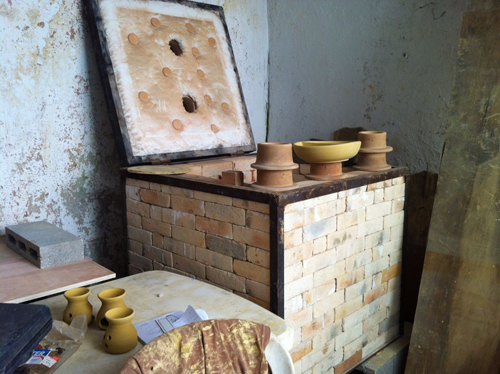
The studio of Natalia Ortega Gamez, who creates ceramic sculptures, among other works, is located behind the storefront Taller las Mercedes, located in the historic center of Santo Domingo, Dominican Republic, where the artist and her collaborator Ysabela Molini create experimental design objects.
SHCC: The experience of the studio visit—whether it is in the artist’s workplace, at their home or in a cafe with a laptop—is what I most value of my curatorial process. I consider it a privilege. I’ve learned to see the world through art, and to think about it with artists. I’ve done studio visits for over a decade, and it doesn’t matter how many I do, I am always humbled by it.
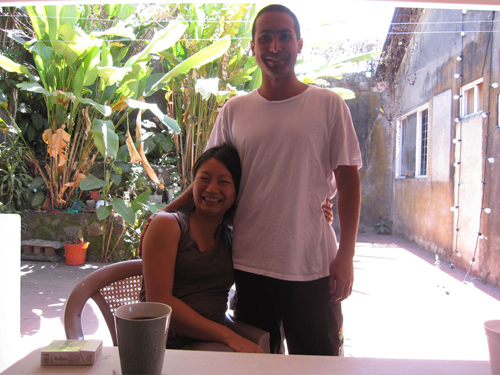
The patio of the artist-run space Des Pacio in San Jose, Costa Rica, has served as a pleasant, outdoor space to informally meet local artists or review their portfolios. Here pictured are Des Pacio’s founder, Federico Herrero with the artist Rocío Con, also collaborator to the space.
For a decade now, I’ve been in a relationship with an artist named John Menick, and married to him for more than half of that time, and there is no doubt that our lives together, our conversations and our circles of artists friends, have informed my own comprehension of artistic processes. So, on a personal level, art and artists are part of my life—studio visits being part of my everyday culture.
On a practical note, I think there are several roads that one can take to arrive to an artist’s studio. In the case of my field research, it all depends how much I know or don’t about an art scene before my arrival, and whether I plan to go to a place with specific topic-oriented research project in mind. Artists tend to be the best recommenders—they put you in touch with their peers—so I tend to ask recommendations to one so they can put me in touch with the rest. And I take it from there. I also have a solid network of curators worldwide who I’ve met along the way, whether at school, in conferences or at work, and we all share constantly our contacts, recommending exhibitions to see and artists to meet.
In Cuba, for example, I was going to do a specific research on an art school, ISA. In the week that I spent there, I had about 30 appointments with artists ranging in age from 21 top 67, whether because they were students or teachers or dissidents of ISA. Whenever I felt more interested in some trend or thought, I asked the artist then and there who influenced them or who they discuss their ideas with; most times, that led me to meet other artists that were not part of my specific research project—those studio visits taking place in edges of the itinerary, either very early in the mornings or late at night.
In Costa Rica, it was totally different. It was my first visit to that country, and my primary contacts were Inti Guerrero, the new artistic director of the independent art space Teoretica, and Federico Herrero, an artist represented in CPPC and also active in the art scene (he founded the space Des Pacio). Inti suggested to several mid-career artists, many who in one way or the other are associated with Teoretica’s exhibition program, and Federico organized portfolios reviews and studio visits with emerging artists from the local scene. As I said, getting to an artist’s studio always has a different road.
I think that one can feel welcomed in a studio if one arrives open to learn rather than teach, to experience rather than judge. Of course, once in a while you can share a thought or an opinion (sometimes because the artist requests it or because the situation is such that you cannot contain yourself!), but the most important things are to know that the artist is the host, that you are a guest, and that the studio may be the mind or heart—the most vulnerable parts of a body—of someone, a place that you are being welcomed in, if at least for a moment. So once there, might as well let go, and see where they take you.
GK: Tell me a little bit about Sideshows and murmur, and your interest in sharing thoughts on contemporary art online.
SHCC: I started those projects pretty much at a time when I was launching my independent practice. Let me rephrase that: Since I started curating, in 2000, I’ve always developed projects and written independently from my institutional work, but in 2008 and 2009 when I launched the blog Sideshows and the editorial project Murmur, respectively, I was decidedly working outside of institutions. Sideshows was a platform to share ideas, experiences and curatorial processes with a public that I could no longer convene in a physical space. Murmur was an excuse to continue developing close collaborations with artists and putting things out there in the world, even if I lacked a whole lot of infrastructure. Both of them continue, but with less intensity, just because I lack desk-time these days with so much travel. I continue to use these platforms, yet at a different pace than when I started.
GK: What is the project at the back of your head waiting to be realized in the near future?
SHCC: I am considering TV as a venue.
And, that’s a wrap!

